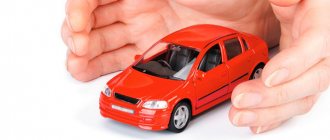What is compensation in kind under compulsory motor liability insurance?
Natural OSAGO appeared on April 28, 2021. The essence of the new bill is that the injured party, in the event of an accident, receives a referral to a station that carries out repair work.
It turns out that this is compensation in which the client does not receive funds in hand, but provides a car for repairs. As for payment, all responsibility rests with the insurer.
As part of the new law, motorists were offered several advantages:
- The time for payment will be reduced, since there is no need to show the car to an expert and wait for the assessment results.
- Often, drivers did not have enough amount received, as a result of which they had to file a claim and go to court. Thanks to this law, the problem of underpayment has been resolved.
- Each driver can choose a station from the available list. Insurers are required to cooperate only with large car dealerships. It turns out that you won’t be sent to the garage for questionable repairs.
Thanks to in-kind compensation for damage under the MTPL policy, the state wants to protect itself from numerous scammers who make fake road accidents in order to gain profit.
Repair requirements
In connection with the entry into force of amendments to the Federal Law “On Compulsory Insurance...”, new requirements for repairs have appeared, according to which they must be carried out only by services with which the insurance company has entered into contracts. An exception is the company’s consent to carry out work on other services in the absence of an agreement at the request of the car owner.
What are the rules for compensation for damages under compulsory motor liability insurance?
- new cars under 2 years of age should only be repaired by authorized services. If there are none, and the owner of the vehicle does not agree to carry out repairs at another station, he is required to transfer money for damage in the event of an accident;
- A 12-month warranty is provided for paint work and six months for replaced parts. The insurer is responsible for repairs, and if it receives too many complaints, the Bank of Russia may oblige it to pay for the damage in cash;
- If more than two cars were damaged in an accident, their owners can contact their insurer, and subsequently their insurance company will deal with the insurance company of the culprits.
Is it possible to get money
Having studied the reviews on the Internet, it becomes clear that not all car enthusiasts liked the innovation. Many road users are interested in whether it is possible to get cash and pay for repair work themselves.
The law provides for exceptions, as a result of which money is paid under compulsory motor liability insurance. Cash payment is made:
- heirs by law in the event of the death of the victim;
- if the victim suffered moderate harm to health;
- if the injured party is disabled and the car is necessary for medical reasons;
- in case of complete loss of the car;
- if the cost of repair work exceeds the established limit, within 400 thousand rubles, and the culprit does not agree to voluntarily pay the difference;
- with mutual guilt;
- if the insurer cannot ensure that repair work is carried out at the relevant station.
Also, payments under compulsory motor liability insurance in cash are provided by agreement of the parties. It is important to consider that the agreement must be in writing and signed by both the policyholder and the insurer.
Compensation in kind under compulsory motor liability insurance failed
Almost six months have passed since amendments were made to the law on compulsory motor liability insurance, which introduced so-called compensation in kind to the market. However, the mechanisms that officials so hoped for do not actually work.
As you know, according to the requirements, a damaged car under two years old must be repaired at a service station of an official dealer. In this case, only new spare parts should be used. Insurance companies can choose whether to provide clients with an in-kind form of compensation or assess the damage and pay out money. As practice shows, insurers choose the latter option - it is more profitable. Assess the parts, taking into account their wear, and pay the owner of the insurance policy cheaper than paying for new spare parts.
“The in-kind form of compensation is reluctantly used by insurance organizations. This is explained by the fact that operational wear and tear with this type of damage compensation is not taken into account, and the insurer is interested primarily in profit, and not in increasing its costs. Therefore, when settling an insured event, insurance organizations strive to close the issue with the client by compensating for the damage in cash,” explains Alexey Dryuchenko, chairman of the board of the Primorye public organization for the protection of the rights of car owners “Regional Society of Car Owners of Primorye.”
A participant in the car insurance market, on condition of anonymity, explained that the task of insurers is not to compensate for all damage, but to make money. Accordingly, no one worries about the client’s benefit. “The damage assessment catalog has no connection with the market at all. Firstly, the catalog is uniform throughout Russia and has nothing to do with the cost of spare parts on our side of the Urals. Secondly, the task of the assessment is to reduce the amount of payments,” said interlocutor “K”. “This is done due to the fact that spare parts for popular cars, as well as those parts that suffer most often in road accidents, are priced below the market in the catalog. But spare parts for rare cars or those parts that rarely suffer in accidents are overpriced. For example, roofs are more expensive in the catalog, but bumpers are cheaper. This results in an average price that seems quite normal.
The Central Bank says that the catalogs need to be revalued, but this will be unprofitable for customers. After revaluation, what is cheap will be even cheaper, and what is expensive will become more expensive. Due to the current system, it is more profitable for insurers to give money to the client, but this will be about 30% of the actual cost of repairs and spare parts. In case of an insured event with an old, rare car, they must pay out such an amount that sometimes you can buy two such cars. And in this case, it is more profitable for insurers to receive compensation in kind. The situation with wear and tear is generally disastrous. There were used spare parts - so you will get used ones, no one will do better than what was done. Repairs at official dealers are always expensive, and insurers practically ignore the opportunity to send clients there.”
Car dealers note that over the past six months, insurers have referred virtually no clients to them. “It is not profitable for dealership centers to work under compulsory motor liability insurance now, since insurers estimate prices for RSA, the cost of work, paintwork materials, and original spare parts below cost. It is profitable to work under OSAGO only for those body shops that work under the table and use Chinese or used spare parts instead of new original ones. And there is no need to explain to anyone what a Chinese body part is,” notes Igor Chebotarevsky, executive director of Vostok-SV .
“For our part, we have completed all the procedures and are ready to accept cars for repairs as part of payment in kind under compulsory motor liability insurance, but we do not feel any significant flow of such clients at all. Owners of new cars regularly turn to us for restoration after an accident, but they apparently somehow resolve issues with insurance companies themselves,” says Leonid Kopylov, Marketing Director of Sumotori Group of Companies.
Alexey Dryuchenko: “Today, payments under compulsory motor liability insurance do not always provide the opportunity for a car owner to restore a damaged vehicle without additional costs. The cost of restoration repairs is made in accordance with the unified methodology (EM) for determining the amount of costs for restoration repairs in relation to a damaged vehicle. We have repeatedly submitted information to the Central Bank of Russia, RSA (Russian Union of Auto Insurers), and FAS Russia about the discrepancy between the estimated cost of parts produced in accordance with the EM and the cost determined by the market. This mainly applies to left-hand drive cars.
Firstly, the cost of one standard hour of work established by EM for a car, for example, Toyota, is 970 rubles, the cost of a standard hour established by an official dealer is 3000 rubles, the market value of an hour of work performed is 2000–2500 rubles (for others car brands, the cost per hour is also several times less). Secondly, for this range of machines there is no market for contract spare parts and the purchase of new parts is required, and EM provides for operational wear of up to 50%. But nevertheless, in accordance with the current requirements of the law, the only way for a car owner who does not have enough insurance payment to restore his car is to reimburse the difference directly from the one who is at fault for the accident.”
“Spare parts for those cars that are selling well now are rated especially poorly,” said another K source. “This leaves a significant hole in the budget for car buyers from a dealership in the event of an accident - they simply don’t get enough money, but they need to have it repaired at the dealer.”
Ksenia Sukhikh
How are service stations for repairs determined?
The new rules spell out how compensation occurs for natural compulsory motor liability insurance and the choice of station. Having studied them, it will become clear that:
- The service station is chosen by the client, and not determined by the financial company at its own request;
- the insurer is obliged to issue a direction to a point that is located no more than 50 km from the scene of the accident or the registration of the car owner;
- if there is no service station nearby, then the insurance company is obliged to offer another one and pay the costs associated with additional transportation;
- resolve the repair issue within 30 days.
Important! If the financial company does not resolve the repair issue within 30 days, then, within the framework of the law, it will be obliged to pay the client a penalty for each day of delay. The penalty amount is 0.5% of the amount of damage.
When will the damage be compensated in money?
Cash compensation under compulsory motor liability insurance according to the new 2021 rules in case of an accident has not been completely canceled, and it is quite possible in the following cases:
- the car cannot be restored;
- it was not possible to find a suitable car service;
- the owner of compulsory motor liability insurance or another victim died in an accident, and relatives apply for payments;
- the company itself agreed to pay for the damage in money;
- the victim suffered moderate or severe injuries in the accident;
- the cost of repairs exceeds the maximum payment - 400,000 rubles;
- the victim has a disability.
The procedure for compensation in kind under OSAGO
Payment for motor vehicle liability under natural compulsory motor liability insurance is possible only after receiving written consent from the victim. Let's take a closer look at the payment procedure:
- Selection of service station. When contacting the loss settlement office, you must fill out an application indicating the name of the service station where you want to repair the damaged vehicle. As soon as the application is completed, the injured party receives a direction with which it is obliged to travel to the selected point. Application deadlines are strictly fixed, so do not delay.
- Providing transport. It is necessary to transfer the damaged car to the station and sign the acceptance certificate for the transfer. It is this document that indicates that the car is being transferred for repair work. The period during which the service station is obliged to fulfill its obligations is also fixed.
- Signing the act of completed work. The repaired car should be accepted according to the certificate. If you are not satisfied with the quality of the work, then you should not sign the document. In such a situation, you should write a statement asking to correct the shortcomings. If you receive a refusal, you should go to court. It is important to take into account that you do not need to show the repaired car to the insurer.
What is more profitable: compensation in kind or money?
With the introduction of new amendments on compensation in kind for compulsory insurance, motorists began to think about what is more profitable: money or repairs. To answer this question, you need to understand what the client wants:
- quickly repair the car without solving financial issues;
- earn money and not do repairs.
Payment in kind is beneficial because:
- the client can receive a referral to a specialized service station on the day of application;
- no need to pay at the station yourself;
- You don’t have to worry about not having enough money to pay for the repairs;
- The car can be restored within a few days.
Payment in cash is advantageous because:
- the client himself decides whether to restore the car or not;
- the victim can repair the vehicle himself and save money.










